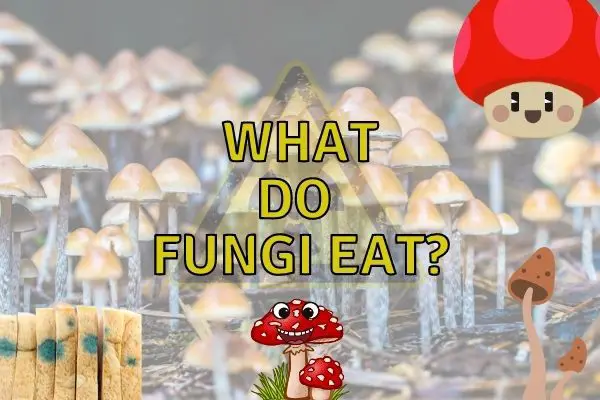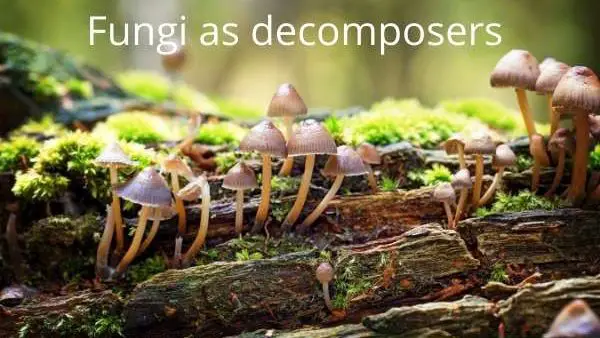There are many different types of fungi that eat different things, but common to them all is that they are important decomposers, playing a vital role in the recycling of nutrients in ecosystems.
Fungi have a very broad diet consisting mostly of dead plant and animal matter, simple sugars from fruits, and even radioactivity! They eat by releasing enzymes into their environment, decomposing organic matter, and absorbing the resulting nutrients.
Their role in ecosystems is to break down dead organic matter into its component parts so that the nutrients can be recycled in the ecosystem.
This effectively defines fungi as decomposers, which does reveal their main dietary preference: dead things!
We will get more into the different types of fungi and what they eat in different ecosystems, and how radiotrophic fungi survive in the extreme conditions of nuclear fallout!
Contents
Fungi are Important Decomposers
While there are pathogenic fungi that cause infections and effectively try to eat living animals, most fungi will much rather engulf already dead organisms.
If you look out in nature, you will discover that the ground is covered in dead things that used to be alive, however, these things magically disappear and turn into soil!
We can thank decomposers like fungi for this heroic effort!
Fungi are, along with bacteria, the most important decomposers on the planet. They perform this vital role by breaking down dead plants and animals to recycle their nutrients back into the soil.
This is important for two reasons. Firstly, it helps keep ecosystems healthy by returning essential nutrients back into the soil. Secondly, it helps to remove pollutants and break down materials that would otherwise stay around forever!
In forests, fungi are an important part of the decomposer community, breaking down dead leaves, sticks, and branches. In doing so they decompose carbon-rich organic matter into its component parts like amino acids and sugars that eventually end up in larger plants and animals (that then die to complete the cycle…).
How do Fungi Eat?
Common for all fungi is that they are immobile and therefore cannot hunt or seek out food as most animals can.
Depending on the type of fungi, they will release different enzymes into their environment to decompose the organic matter around them. Fungi then absorb the resulting nutrients through their cell walls.
The nutrients resulting from the enzymatic breakdown are in the form of sugars (like glucose, fructose, galactose etc.), amino acids, and fatty acids.
These breakdown products are all small enough to be absorbed directly by the cells of the fungus and used for metabolism and growth.
Do fungi have mouths?
No, fungi do not have mouths like animals.
They digest their food outside their “bodies” and therefore do not need to ingest larger pieces of food as animals do.
Whereas animals digest their food via an internal digestive system, fungi use an external digestion strategy where food is digested in the environment and only ingested by the fungus when fully digested into its molecular components.
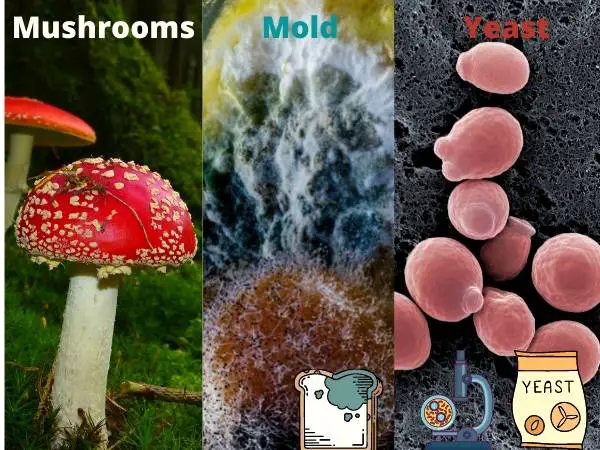
How do Mushrooms eat?
Mushrooms are the most obvious component of fungi found on land, and they are frequently discovered in association with trees since this lets them to eat the decomposing leaves and other plant matter that fall to the ground.
Mushrooms are common decomposers in the forest, which means they eat dead plants for the most part. They live in the soil, or they can grow on logs or trees.
Mushrooms absorb nutrients through an extensive network of fine veins underneath the upper soil layer called “hyphae”.
Hyphae consist of connected fungi cells that are similar to those of the mushroom above ground, but they serve an important function in how fungi feed.
The hyphae of mushrooms and molds form a network called a “mycelium”, which is used to absorb and distribute nutrients to all the cells of the fungus.
How do Molds eat?
Molds are another group of fungi that are filamentous, meaning that they have hyphae like mushrooms, but they do not cover the same ground and do not make an actual mushroom (fruiting body) like mushrooms do.
Like mushrooms, molds digest their food by secreting digestive enzymes onto their food source, decomposing it, and absorbing the nutrients.
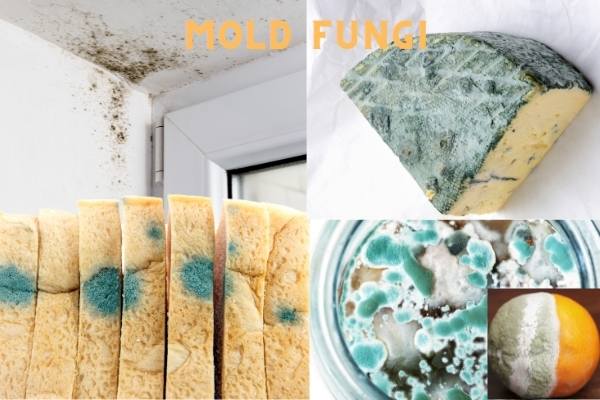
Molds are decomposers that love warm, moist environments. They form spores that travel through the air to spread the molds around.
Some common molds include:
- Aspergillus niger (black mold)
- Eurotium amstelodami (green mold)
- Penicillium chrysogenum (the source of penicillin)
Molds can be found in many different places, such as on food, dying trees, and in houses. Molds can grow on almost any surface, as long as the temperature is warm and the humidity is high.
Molds are not always bad when growing on foods as certain molds are able to contribute a beneficial flavor profile to e.g. cheeses and sausages, without being unhealthy to eat!
Molds typically grow in the dark so they are not dried out by the sun, so they are more common in damp areas like basements, under the top layer of dead leaves in the forest, or in your fridge!
How do Yeasts eat?
Yeasts are single-celled fungi with a somewhat different diet than mushrooms and molds.
Yeasts are much pickier with their food and they often prefer the simple sugars of fruits decomposing grains, rather than the complex carbohydrates of wood and leaves.
Whereas most molds and fungi need oxygen to survive, many yeasts can live without oxygen and can therefore also exist in our intestines, deep underground or even underwater.
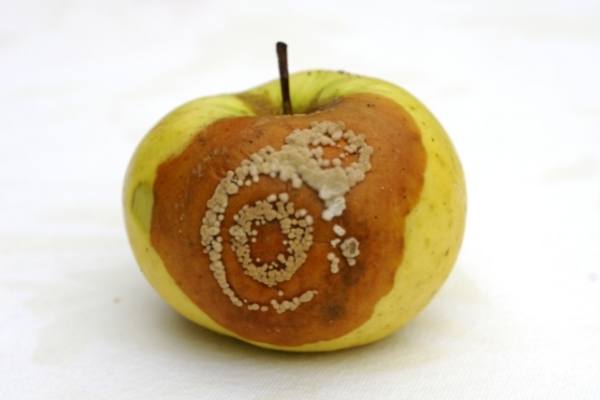
Their ability to grow completely submerged in liquid, allows them to completely colonize and effectively feed on the sap of fruits which is exploited in the brewing of wines, champagnes, and beer.
How do fungi eat dead animals?
In most ecosystems on earth, decomposers eat dead animals as well as plants. Fungi are no exception.
Fungi eat dead animals, in the same manner as they eat dead plants: by secreting enzymes that break down the flesh of the animal and bring the amino acids back into the yeast cells where they are converted to building blocks and energy.
This decomposing process is important for the recycling of nutrients in an ecosystem and for the return of carbon to the soil.
Why do fungi mostly eat dead plants or animals?
Because it is much easier than dealing with the immune systems of living plants and animals!
Another reason is that it is much harder for fungi to get in contact with living animals or plants as they have to reach them although they cannon move.
However, there are indeed fungi that feed on living plants and animals!
Do fungi also eat living things?
Yes! There are many pathogenic fungi that infect living plants and animals.
Fungi that “eat” humans include:
- Candida, a yeast that causes thrush in the mouth, vagina, or diaper rash.
- Cryptococcus; has mold and yeast states and can cause meningitis.
- Mucorales; are molds that can cause fatal infections in the lungs and sinuses.
These fungi can cause everything from ringworm to meningitis but mostly affect immunocompromised individuals.
In plants there are more than a thousand different species that infect living plants, these include the funguses that cause Dutch elm disease and chestnut blight.
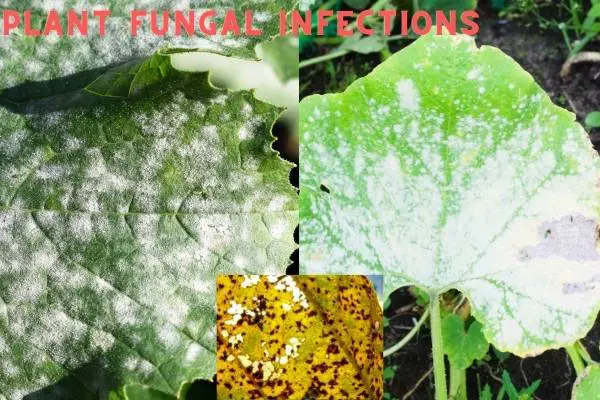
Vegetable garden owners may also be familiar with plant diseases such as powdery mildew, Rusts, and downy mildew caused by various molds.
Fungi may also collaborate with other living organisms for food!
Fungi may also ally up with living things like plants or algae to gain mutual benefit. Such symbiosis is, for example, seen in mycorrhiza and lichens.
Mycorrhiza is a type of fungi that lives in the soil. It helps plants get nutrients from the soil, in return for the sugars produced by the plants via photosynthesis.
Lichens are also an alliance between algae and fungi. The algae provide the fungus with food and water, while the fungus protects the algae from environmental stresses and helps it to safely do its photosynthesis.
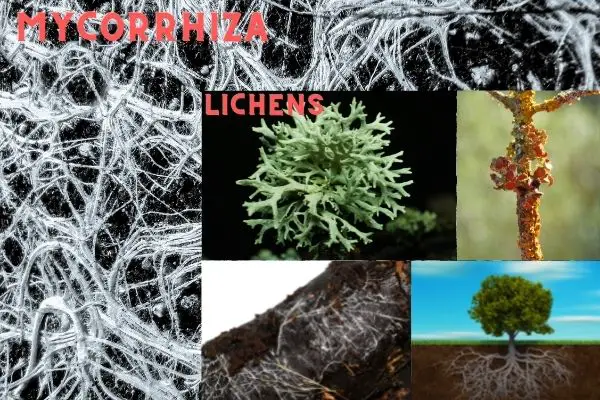
What do Fungi Eat in the Rainforest?
We have talked a bit about what fungi may eat in forests, but what do they specifically eat in rain forests such as the Amazon rain forest?
Fungi in the rainforest eat mostly leaves, fruits, fallen trees, dead animals, and dung. But pathogenic fungi like the ant-eating Ophiocordyceps are also around!
Fungal decomposers in the rainforest have to be able to digest a huge variety of different plant and animal materials because there is such a large diversity of life and decomposing matter in the rainforest.
This means that there are many different types of fungi in the rainforest that have evolved to eat a wide variety of plant and animal materials.
Ophiocordyceps is an interesting example of a pathogenic fungus found in the Amazon jungle. It does not decompose dead matter like other fungi, instead, it eats living prey!
Ophiocordyceps is a mold that infects ants and takes control of their minds. It forces the ant to climb high up into the canopy where the fungus eventually kills the ant and feeds on its dead body to grow and produce spores that will fall down to infect more ants.
Such fungus may be seen as both a parasite, consumer, and a decomposer as it is technically a secondary consumer that also kills and breaks down the dead host.
Because of the immense need for energy in the rapid growth in a rainforest, fungi (as well as other microorganisms like bacteria!) are a very important part of these tropical ecosystems.
What do fungi eat in the savanna?
Savannas are often dry warm which is not the favorite climate for most fungi, but nevertheless, thousands of species can be found there.
Although there are not as many things to decompose as in the more densely populated ecosystem of the rain forest, the savanna is home to numerous plants and animals that fungi can eat when they die.
Whereas less fungal growth happens in the dry seasons, many fungi use periods when it rains to grow and procreate due to the increased humidity that fungi love.
Examples of mushrooms found in the savannas of Africa are:
- Termitomyces Titanicus (Giant mushroom!)
- Pleurotus sp. (Including Oyster Mushrooms)
- Common button mushroom
- Coriolus Versicolor (turkey tail)
- Thousands of yeasts and molds!

Blimeo, CC BY-SA 4.0, via Wikimedia Commons
What do fungi eat in the desert?
The desert is perhaps one of the most hostile environments to fungi, resulting in relatively few species thriving here.
In fact, studies have shown that only about 3% of total life forms in dessert sand are fungi.
This is mostly due to the limited availability of water to support other life-forms that fungi can decompose.
Those that do survive the harsh conditions of the desert, do so by eating the few plants like palm trees or succulents (cacti), but some also infect or decompose animals like insects or dessert mice.
Numerous Fusarium molds exist in deserts where they mostly feed on the aligning of dead plants. But actual mushrooms like the Astraeus hygrometricus (puffballs) the Terfezia (a truffle-like mushroom), and Podaxis pistillaris – an interesting mushroom that looks like a puffball on a stem!
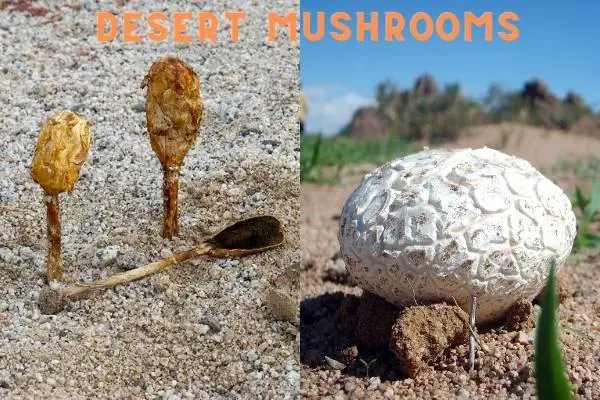
These fungi stay as spores during the intense heat and only germinate when the rain falls.
Being able to survive extended periods in a protected spore form, makes fungi very important decomposers in the hostile environment of the desert!
What do fungi eat in the ocean?
Fungi are not just terrestrial organisms, but can also be found in aquatic ecosystems.
Marine fungi can be found in many different places, from the depths of the ocean to mangrove swamps.
There are two types of marine fungi: harmless decomposers that eat dead organic matter and parasitic ones that feed on animals or plants.
Marine fungi decompose both plant and animal matter of the seabed and are an important part of the marine food web.
This is because they are able to decompose the tough cell walls of algae and other seaweeds and plants, as well as the hard shells of crabs and lobsters.
Fungi use an enzyme called chitinase to digest the chitin shells of crabs, lobsters, sea urchins, and an enzyme called laccase to break down the lignin making up a large part of the cell walls in plants.
Other important marine fungi decomposers include wood-degrading fungi, which need to be able to break down the strong cellulose used in plant cell walls in order to decompose the wood.
There are even actual mushrooms growing underwater like the Psathyrella aquatica found in some rivers.
Can fungi live off radiation?
So, we have gone through what different fungi can live on in some quite extreme environments like the dessert, but fungi can actually be found in even more extreme settings like those of highly radioactive nuclear reactors!
So how does this relate to what fungi eat, you might think?
Well, it turns out that these extreme fungi might actually absorb their energy directly from radiation – a process called radiosynthesis – rather than from organic matter like most other fungi! This effectively makes them autotrophic (self-feeding) rather than heterotrophic (feeding on others) like the vast majority of fungi out there!
Fungi that obtain their energy from radiation using radiosynthesis are termed radiotrophic fungi.
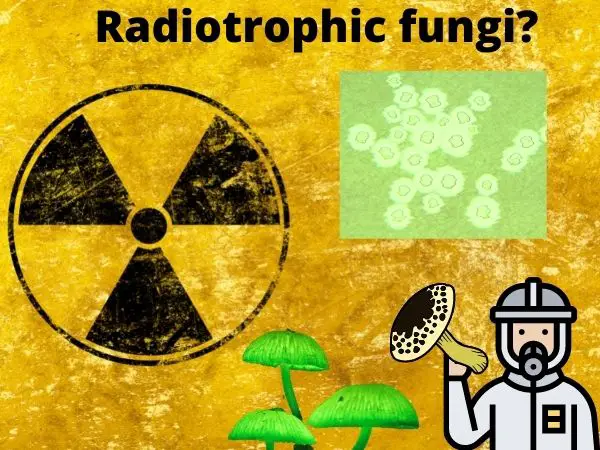
It is believed that radiotrophic fungi are able to absorb radiation from radiation sources such as uranium and convert it into small amounts of energy that can help them grow.
Radiotrophic fungi seemingly thrive in strong radiation and can even use it for energy!
These fungi were first discovered in the leftovers of a Nuclear Reactor in Chernobyl in Ukraine.
What makes it particularly fascinating, was that the fungi that are able to survive these high levels of radiation did not just protect themselves, they actually exploited it and thrived better than without it!
So how does radiosynthesis in fungi work? Simply speaking, it works because the fungus absorbs the radioactive radiation into its melanin pigments where it uses the released electrons to generate cellular energy that can be used for growth!
If you’re interested, I wrote more about radiotrophic fungi in this article on heterotrophic and autotrophic fungi.
Conclusion
This blog post discussed what fungi, including yeast, molds, and mushrooms, eat in different ecosystems.
Fungi play an important role in decomposing matter in different ecosystems. They eat a variety of things, including leaves, fruits, fallen trees, dead animals, and dung. Some fungi also eat living things, such as ants and even humans!
Marine fungi decompose both plant and animal matter of the seabed and are an important part of the marine food web. Fungi that thrive in strong radiation can also be found in nuclear reactors and may be considered the only autotrophic type of fungi.
FAQs
Do fungi eat sugar?
Yes! All fungi love sugar, especially yeast. This ability is used for making bread, beer, and wine where they convert the available sugars to alcohol and carbon dioxide (which makes beer sparkle and causes the dough to rise!).
Do fungi eat bacteria?
Yes! Fungi are in sharp competition with bacteria in almost any environment as they both function as decomposers of the same materials. Therefore fungi often kill bacteria and feed on their remains.
In fact, one of the most powerful antibiotics, penicillin, was discovered in a fungus!
Other fungi may even cultivate bacteria as a food source!
Pilar Junier, a professor of microbiology from Switzerland, and her colleagues studied the soil fungus Morchella crassipes and soil bacteria in an effort to better understand how this fungus seemingly farms bacteria for food!
They have found evidence that the fungus cultivates and eats Pseudomonas putida bacteria by excreting food for the bacteria first and then digesting them later!
Chytrids are another group of fungi that eat cyanobacteria, which are bacteria but are also sometimes considered to be algae due to their ability to use photosynthesis and presence in water.
Do fungi eat algae?
Whereas the chytrids mentioned above do not really eat algae but bacteria, there are definitely fungi associated with living algae such as seaweed.
Fungi that grow on seaweed are called algicolous fungi. Some of these fungi secrete digestive enzymes that break down the cell walls of algae, effectively making them seaweed pathogens! This allows the algae to be easily digested and used as a food source by the fungi.
But fungi also collaborate with algae in a more peaceful fashion!
Lichens are a symbiosis between fungus and algae, where they not only live together but also feed on each other to survive. However, the fungus is the main feeder here, as it eats the dead algae in return for providing a structure for the algae to grow!
Do fungi eat other fungi?
Yes, fungi will eat and fight other fungi in their vicinity. They do this by producing enzymes or chemicals that break down the other fungi.
But mostly, they will just eat the dead cells of other fungi being present in the environment.
Do fungi eat meat?
Yes! Especially pathogenic fungi are very fond of meat.
Some of these ‘meat-eating’ fungi are found in the tropics, but most pathogenic fungi can be found all over the world. These fungi can be very dangerous as they not only eat meat but also live animals and humans!
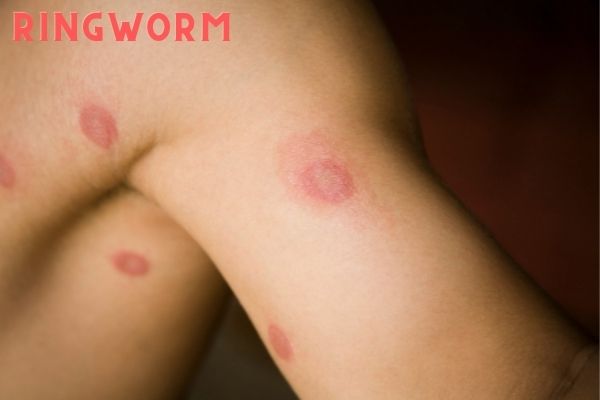
Do fungi eat grass?
Yes, but mostly decaying and dead grass. Fungi in grasslands and prairies are important for breaking down the organic matter in these ecosystems.
There are also fungi that infect grass like the causal agent of Lawn Fungal Disease.
These fungi are called rusts and they attack living grass! But they can also eat dead grass. Many of these attack lawns causing the grass to turn yellow or brown.
Do fungi eat leaves?
Yes! Especially dead ones. Fungi in the leaf litter are important for breaking down the organic matter in forest ecosystems.
There are also fungi that infect leaves, like the causal agent of Dutch Elm Disease.
These fungi eat living leaves and also dead ones, causing the branches to turn brown and die.
Do fungi eat wood?
Yes! Especially dead ones. Fungi in forests are important for breaking down the wood of fallen trees.
Fungi do this by digesting the lignin and cellulose in wood, making it a food source for them!
There are also fungi that infect trees, like the causal agent of Oak Wilt Disease. These fungi also eat living wood, causing the branches to turn brown, brittle, and eventually die!
Do fungi eat rocks?
No, but it might sometimes seem like that as they are able to grow on rocks! Fungi can grow on any surface as long as it has the right nutrients and moisture. However, they do not eat the rock themselves but rather algae, bacteria, or microscopic particles that are present or fall onto the rock e.g. through the rain.

